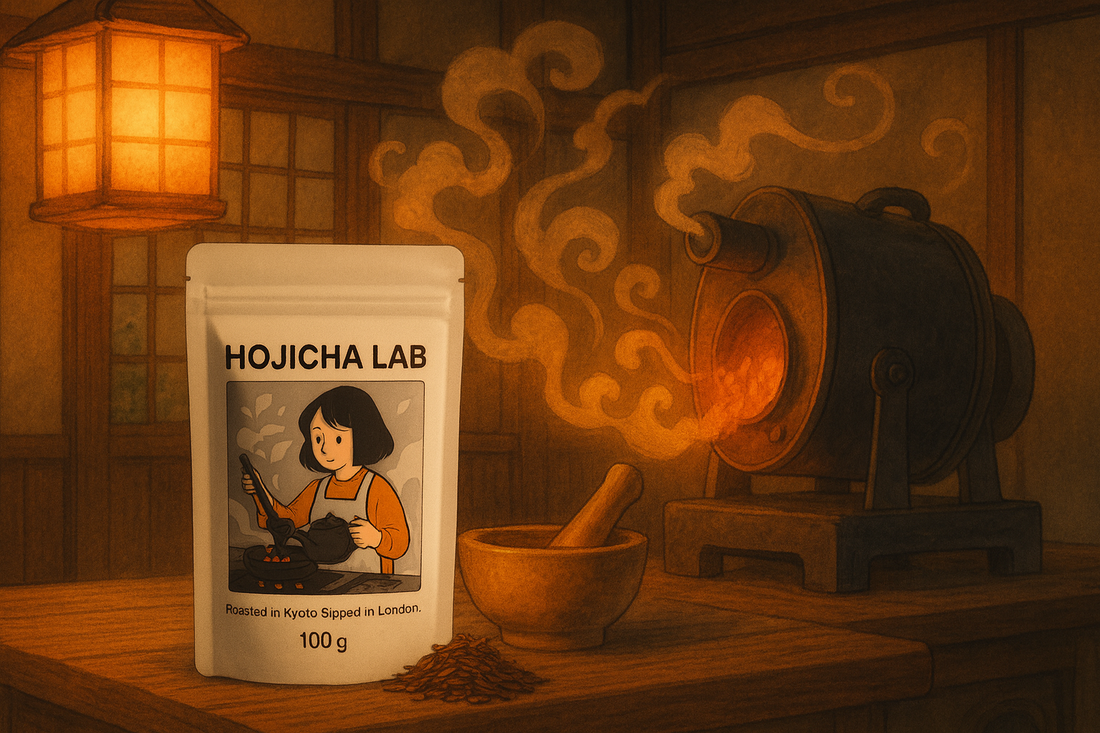
How Hojicha Is Made: The Kyoto Roasting Method (From Leaf to Latte)
How Hojicha Is Made: The Kyoto Roasting Method (From Leaf to Latte)
Hojicha is the cosy, toasty cousin of green tea—born in Kyoto, roasted to a gentle caramel warmth, and adored in lattes. This guide walks you from leaf selection through the drum roast and stone-milling, to the beautiful shift in colour, aroma, and taste that makes hojicha uniquely calming.
The Leaf: Bancha, Sencha, and Kukicha
Hojicha begins as Japanese green tea that has already been steamed to halt oxidation. Producers choose from three main bases:
- Bancha—later-season, larger leaves with mellow flavour; common for everyday hojicha with a round, comforting profile.
- Sencha—earlier harvest leaves; when roasted, it yields a more aromatic, refined hojicha with a cleaner finish.
- Kukicha—leaf stems and twigs (also called bōcha when twig-forward). Naturally lower in caffeine and famed for sweet, nutty notes after roasting.
Blenders in Kyoto (especially around Uji) may combine grades to balance body, aroma lift, and that signature soothing cup.
The Roast: Temperatures, Time, and Caramelisation
Unlike pan-fired or baked teas, hojicha is typically roasted in a rotating drum roaster with steady airflow. The goal is an even, toasty development without scorching.
Typical profile: leaf bed temperatures often sit in the ~140–200 °C range for several minutes, depending on leaf grade and desired roast level (light, medium, dark). Maillard reactions begin in earnest around the mid-140s, while deeper caramelisation (of natural sugars) develops as you approach the upper end of the range.
Roasters listen and sniff: grassy, sea-green aromas fade; warm notes of toasted grain, cocoa husk, and light caramel appear. The roastmaster manages heat ramps and airflow to avoid smoke taint and to “set” the sweetness before cooling rapidly.
Milling into Powder
Loose-leaf hojicha is lovely brewed, but for lattes, desserts, and effortless mixing, the roasted tea is stone-milled (or ball-milled) into an ultra-fine powder. Proper milling protects aroma compounds from heat and produces a silky texture that disperses in water or milk. Premium hojicha powders are typically milled to a fine particle size (often well under 15 µm), giving lattes that café-smooth finish.
Flavour Transformation: From Grassy to Toasty
Roasting reshapes the flavour map. Steamed green tea starts with grassy, marine, sometimes astringent edges. As heat works, Maillard browning and light caramelisation soften bitterness and build comforting notes: roasted barley, hazelnut, gentle cocoa, and toffee. Umami remains in the background, now wrapped in warmth—one reason hojicha feels so evening-friendly.
Colour Shift
Green chlorophyll degrades into olive-brown pigments, and browning reactions deepen the hue. The dry leaf turns chestnut to mahogany; the cup infuses amber to copper-brown. In lattes, that colour blends to a golden-caramel tone—beautifully photogenic.
Aroma Notes
Expect a calm, embracing bouquet: toasted rice, warm cedar, cocoa husk, caramel, and a whisper of smoke (from heat development, not smoke exposure). Kukicha-based hojicha often leans sweeter and nuttier; sencha-base can bring a lighter, aromatic lift.
From Leaf to Latte: A Simple Timeline
- Harvest & Sort: Pick bancha, sencha, or stems (kukicha); grade by size and purpose.
- Steam: Quick steam arrests oxidation, fixing that clean Japanese-green character.
- Dry: Gentle drying prepares the leaf for even roasting.
- Roast (Kyoto method): Drum roast with controlled heat and airflow until caramel-toasty.
- Rest & Blend: Cool swiftly; blend lots for balance (sweetness, aroma, colour).
- Mill (for powder): Stone-mill to ultra-fine particles for silky lattes and baking.
- Sift & Pack: Sieve for consistency; nitrogen-flush and seal to protect aroma.
- Brew or Whisk: Steep loose leaf (short, hot) or whisk powder into water/milk.
Mini Glossary
- Bancha
- Later-season green tea leaves; mellow and ideal for everyday hojicha.
- Sencha
- Early-season steamed green tea; roasted sencha yields aromatic, refined hojicha.
- Kukicha
- Stems and twigs from tea processing; naturally lower caffeine, sweet-nutty when roasted.
- Umami
- Savoury depth found in quality green teas; in hojicha it reads softer under the roast.
- Roast
- Application of dry heat that drives Maillard browning and caramelisation, changing flavour, colour, and aroma.
FAQ
Does roasting remove caffeine?
Roasting doesn’t “strip” caffeine in any dramatic way; caffeine is relatively heat-stable at typical hojicha roast temperatures. Hojicha is usually lower in caffeine because it often uses bancha or kukicha (stems) that start lower in caffeine than tender spring buds—and because many people brew it a little shorter. The result is a calmer cup that’s friendly in the afternoon and evening.
Is hojicha smoked?
No. The cosy, smoky-leaning aroma comes from high-heat drum roasting, not from exposure to wood smoke. Well-made hojicha tastes clean and toasty, never ashy.
Why is it brown?
Roasting transforms green chlorophyll and triggers Maillard and caramelisation reactions, deepening pigments. That’s why the dry leaf turns chestnut-brown and the brew pours amber-to-copper—beautiful in clear glass.